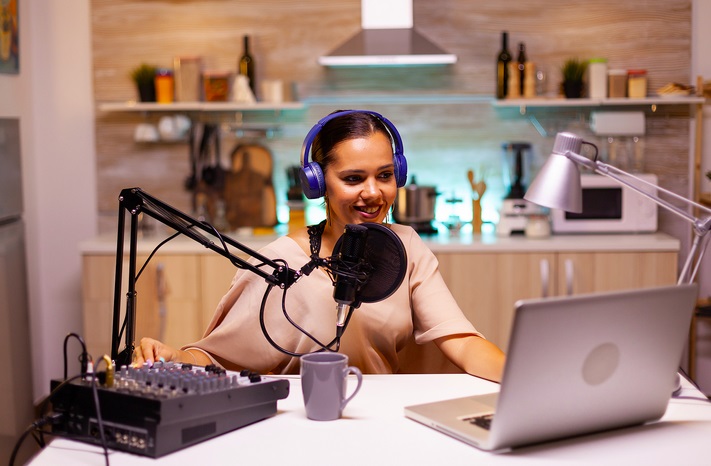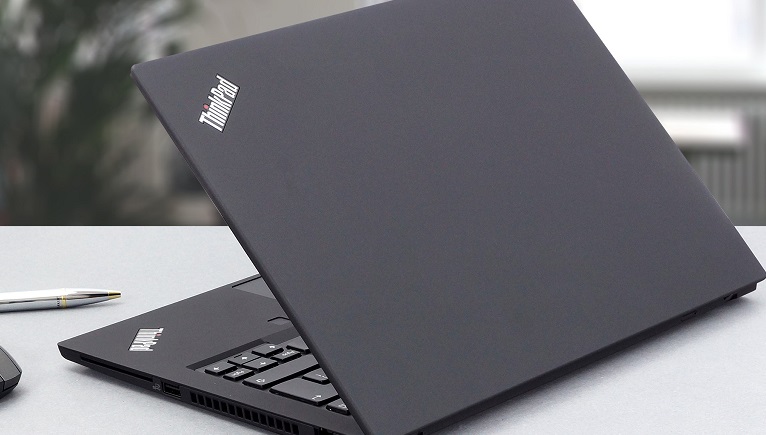How to Record Audio Better on a Laptop
However, recording audio on a laptop can get frustrating if you are stuck with the built-in microphone. Your laptop for audio production also needs to have the right technical specs to run sophisticated software and store large files.

Fortunately, there are many ways to improve the quality of your audio recording, even on a low-budget or mid-range laptop. Follow these tips on how to record the audio better with a laptop:
1. Keep the microphone close to your mouth

When recording audio on your laptop microphone, positioning is everything. If the built-in microphone is on the side of your laptop, it's important that you face the mic directly. Look up where the microphone is located on your laptop's model. Ideally, you want the mic close to your mouth, but it shouldn't be too close or else you'll get a muffled sound.
Once you find where the microphone is, set up the laptop in a position where it's comfortable to record. For the most success, look for laptops that come equipped with lush audio systems, such as the ROG Zephyrus G14 GA401 from ASUS. This laptop features state-of-the-art audio technology from Dolby Atmos, including a noise cancelation system powered by AI. Both the input and the output audio can be filtered intuitively to increase the overall sound quality in this laptop.
2. Use an external microphone

Using an external microphone may help you to record better audio on your laptop. Sometimes, the built-in laptop microphones may pick up noise from inside your device, which can disrupt your audio recording. You will find external microphones to be more reliable and much less noisy to work with. Even an inexpensive external mic can record higher audio quality compared to the built-in microphone.
An external microphone also gives you the ability to set up the best position for recording sound. You have the flexibility to arrange the space between yourself and the microphone. This not only influences the audio quality, but it also makes the audio recording experience more comfortable for you.
3. Record in a quiet environment

Regardless of your audio equipment, one of the simplest ways to enhance sound quality is to record in a quiet environment. Ambient noise, background disruptions, or even a distant conversation can reduce the quality of your recording. Take your laptop to a quiet, enclosed area where you can do the recording without interruption. Remember to shut the door and close any windows nearby.
In general, audio recordings tend to go more smoothly in smaller spaces with sound-absorbing materials. If you have limits to where you can record, try covering the walls with soft metals to absorb the sounds. Covering your walls will also reduce the amount of noise coming from the outside that is picked up by the microphone. Another trick is to record in a carpeted room, which might improve the audio quality since the carpet absorbs ambient noise.
A helpful tip is to look for laptops with noise-canceling audio technology, such as the ASUS ZenBook Pro 15 UX535. This laptop uses sophisticated machine learning to distinguish between individual voices and unwanted noises. It also comes with the ClearVoice Mic feature, which filters out all ambient noises except for human speech.
4. Use a pop filter

A pop filter is a simple device that blocks random bursts of air from being produced when you talk. The filter disperses the bursts of air, especially on words with "b" or "p" sounds. Without a pop filter, these random bursts of air will cause your audio input levels to spike, which will cause popping noises in your recording.
There are many pop filters available in the market, although you can get creative with a homemade version of the device. If you are working with a built-in microphone, you can wrap pantyhose around a wire hanger, using it to create some distance between yourself and the mic.
5. Use an external sound card

Sound cards help your laptop create and record high-quality sound. Most laptops have a built-in sound card, but their quality can vary depending on your machine. Usually, gaming laptops are designed to provide a more immersive audio experience, so you can expect higher quality as a result. Other types of laptops may not prioritize audio recording as much, so the sound card will have limited functionality.
Instead, your best bet is to invest in an external sound card. USB or FireWire soundcards will reduce the burden on your laptop's CPU while recording audio. Sound cards use software to communicate with the rest of the programs on your computer, working together to produce high-quality audio recordings.
6. Edit the audio

Once you record your audio, you can increase the quality of your recording with some meticulous editing. Play around with the equalization and compression values, especially on the sections of your recording that are louder than others. You can use programs like Audacity or Audition from Adobe.
If you have a Mac, iMovie is a surprisingly serviceable editor for audio. iMovie has a setting for voice enhancement, which can help you get rid of the tiny sounds from recordings made with a built-in microphone.
7. Keep your drivers updated

It's also a good idea to check that you have the most recent audio drivers installed. Even with an external microphone, you won't get the best performance if you have drivers missing, outdated, or corrupted. With a Windows computer, you can use the Device Manager to download drivers from the manufacturer's website.
You should read it
- How to record audio on Windows 11
- The easiest way to record audio on a computer
- 9 Best USB Audio Interface
- The simplest and fastest way to record audio on a computer
- How to Record Audio from a DVD
- How to record audio files in Windows 10
- How to Record Calls on Skype
- How to Record Voice on Phone
- How to record audio/narration in DaVinci Resolve 18
- How to record system audio on Linux
- How to record the screen with external audio on iOS
- How to Record on an iPod for Free
May be interested

Lenovo introduces 2 new tablet models Tab P11 5G and Tab P12 Pro

Lenovo introduces new Yoga Slim 7 Pro and Yoga Slim 7 Carbon laptops

Laptop Buying Guide: How To Choose A Laptop That's Right For You

Choosing an outstanding laptop for graphic design and video editing

Surface Laptop 4 review: The perfect laptop for everyday use

Steps to Install Driver for Lenovo ThinkPad Laptop with System Update






 How to record audio on Windows 11
How to record audio on Windows 11 The easiest way to record audio on a computer
The easiest way to record audio on a computer 9 Best USB Audio Interface
9 Best USB Audio Interface The simplest and fastest way to record audio on a computer
The simplest and fastest way to record audio on a computer How to Record Audio from a DVD
How to Record Audio from a DVD How to take photos, record videos with Laptop
How to take photos, record videos with Laptop